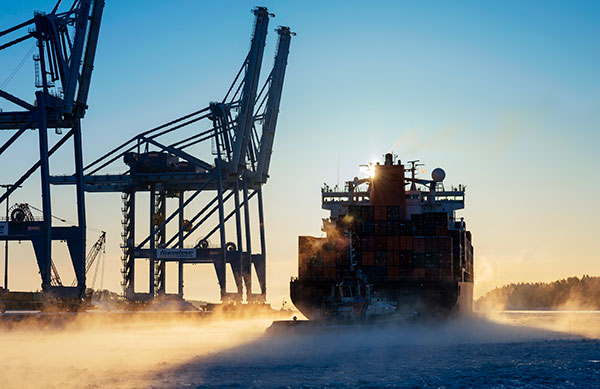Ports
Systems
When data economy hits maritime: shared dataspace boosts port performance

How could cargo vessels schedule their arrival at a port’s newly freed up berth in a timely manner? How could more accurate timetables for unloading a ship be provided to different port operators? And finally: How could the entire logistics chain be made more efficient, becoming fully optimised with a more comprehensive situational picture? The new Maritime DataSpace project, spearheaded by national traffic management agency Fintraffic, is currently searching for answers to these questions. The Maritime DataSpace project is expected to lay a foundation for a groundbreaking shared port stay
data communication service.
This means that, for the first time in Finland,
Fintraffic’s Vessel Traffic Services
is taking a long, hard look at the utilisation
of dataspace architecture in the communication
of information between different
maritime logistics actors. The goal:
information related to port stays is communicated
between different actors in a
transparent, reliable manner and based on
common rules.
DATA MUST FLOW
Project Manager Olli Soininen from Fintraffic’s
Vessel Traffic Services says that Finland
is well positioned to further develop
data exchange between different actors
in maritime logistics. Soininen notes that
national maritime and port logistics can already show “strong evidence” of many
data-driven services in which the real-time
sharing of time data and opening of interfaces
has made the interplay of ports and
arriving ships more efficient.
“The objective of our Maritime Data-
Space project is to expand the communication
of information related to port
stays for use by several operators using a
shared data communication service,” says
Soininen.
In 2023, Maritime DataSpace project
will implement specifications for data
communication service solutions that will
ensure the secure, transparent and common
rules-based communication of data.
This year the project also intends to test
the solution model with a pilot implementation of the scheduling of two different
port stays. Fintraffic serves as the dataspace
operator in the project which will
run until the end of 2023.

TWO MODELS OPTIMIZE
OPERATIONS
Naturally, there are many factors behind a
well-functioning logistics chain. One key
factor is timetable data that is as accurate
as possible, linking maritime and land
cargo into efficient transport chains. In
fact, the Maritime DataSpace research project
utilises the ‘Just in Time Port Arrival’
and ‘Virtual Port Arrival’ operating models
to enhance and optimize vessels’ arrival/
departure at ports, while reducing fuel
costs and CO2 emissions from vessels.
Of the two models, Just in Time Port
Arrival is more self-explanatory, simply
meaning that a vessel arrives at the port
at the right time, as planned, just before
loading or unloading begins. The operating
model is based on real-time information
exchange between the vessel, port
and other stakeholders, which enables efficient
scheduling and smooth traffic.
The main idea of the Virtual Port
Arrival, on the other hand, is the creation
of an operating model that provides information to vessels if there is no berth available
at the port at the planned time. In this
case, the vessel can slow down its speed
and aim its arrival to the time when a berth
will be available.
A vessel acknowledges its berth reservation
to the port virtually, in which case
it is recognized that the vessel is arriving
at the port after the berth is made available
and the vessel is normally in the service
queue. This model generates clear savings
in fuel costs and CO2 emissions for vessels, allowing them to optimize their
speed based on the actual availability of
the berth.

photo: Pixabay
NUMBER OF BENEFITS
Olli Soininen explains that the benefits
brought about by both operating models
largely depend on the type of sea freight
transport, being the greatest for tramping.
“Faster turnaround times, shorter
waiting times and lower fuel costs and CO2
emissions result in computationally significant
savings for terminal operators, ports,
cargo and vessel owners,” Soininen says.
The Maritime DataSpace project is
funded by Sitra, and it is a part of the
development of NEMO, the national Port
Call Time Stamp and Estimation Service.
Fintraffic’s partners in the project include
Siili Solutions and Awake.ai, who are
responsible for technological development.
The project pilot will be carried out
at the Port of Oxelösund, Sweden.
by: Sami J: Anteroinen
FINTRAFFIC’S VESSEL TRAFFIC SERVICES
– maintains and develops one of the world’s most extensive maritime traffic
control and management systems
– promotes the new service models needed for automated maritime traffic,
including information and situational awareness services as well as
remote vessel control and support for remote pilotage
– seeks to utilize digitalization extensively, ensuring the competitiveness of
Finnish shipping and the emergence of intelligent maritime traffic
– actively promotes the development of transport ecosystems both
nationally and internationally
– Fintraffic’s Time Stamp and Estimation Service and Port Activity app were
used as model examples for reducing marine climate emissions at UN’s
COP27 Climate Change Conference in Egypt



